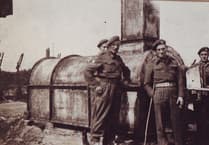This January marked the 250th anniversary of the birth of George Overton, one of Wales’ most important early civil engineers, who lived in the village of Llandetty near Talybont-on-Usk.
To commemorate the milestone, members of the local community, along with representatives from the Diocese of Swansea and Brecon and the Institution of Civil Engineers (ICE), visited Overton’s grave at St Tetti’s Church in Llandetty. The gathering was followed by a talk and buffet hosted at Llandetty Hall Farm.
Stephen K. Jones, historical engineering lead for ICE Wales, said: “Every year we choose some historic events to celebrate. January 16 is the 250th anniversary of George Overton’s birth, which we were really keen to mark, as he played a key role in railway development and this year is being celebrated as RAILWAY 200.”
Overton’s early work focused on tramroads for horse-drawn trams, but his Merthyr Tramroad was also used to trial the world’s first working steam locomotive in 1804. Later, he engineered the Brinore Tramroad, which connected the Brecon and Monmouthshire Canal at Talybont-on-Usk with the Tredegar ironworks and Trefil limestone quarries.
Overton bought Llandetty Hall in around 1815, near the canal where he worked on Brinore.
Today, the wharf at Talybont is still known as ‘Overton’s Wharf,’ and walkers can follow the eight-mile route of the Brinore Tramroad to Trefil.
The ICE plans to install a commemorative plaque on the canal towpath near Llandetty.
Local minister Revd Liz Bramley said: “We are delighted that George Overton’s achievements will be commemorated locally in Llandetty. Our historic and environmental heritage at Llandetty Church already makes the church and churchyard a popular place for visitors and the local community, and knowing that it contains the grave of an important pioneer of rail transport adds to its historical heritage interest.”





Comments
This article has no comments yet. Be the first to leave a comment.